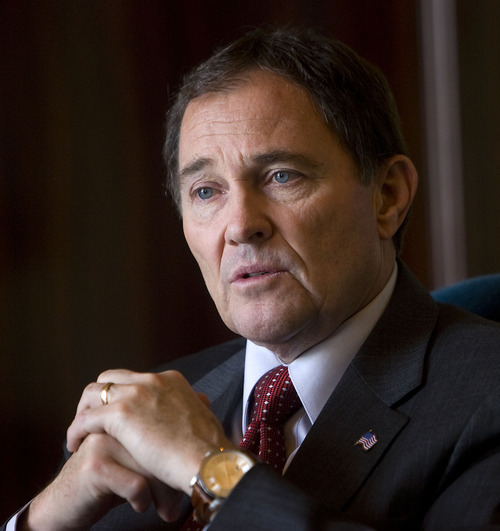This is an archived article that was published on sltrib.com in 2011, and information in the article may be outdated. It is provided only for personal research purposes and may not be reprinted.
Beaver • Gov. Gary Herbert got a real taste of central Utah's economy Friday during a visit to Beaver County.
As part of his jobs tour through rural Utah this week, the governor spent part of the morning at the Dairy Farmers of America Cooperative, which has operated in Beaver since 1954.
As does anyone who tours the facility, Herbert had to don a protective smock, hair net and booties before entering production areas where the painted concrete floors had recently been disinfected.
Manager Craig Willden said the plant handles 600,000 pounds of raw milk a day from cooperative members. After being processed through a number of vats, mixers and evaporators, the liquid is turned into everything from condensed milk to kosher heavy cream, six varieties of cheese and "squeaky" cheese curds the governor said he loves.
The cooperative is an economic staple in this small town, employing 29 full-time and five part-time workers. Twenty to 30 dairy farms regularly deliver milk there, but the co-op accepts milk from 107 producers around the state. Any excess is shipped around the country.
"These are ways to enhance opportunities in Utah and increase employment," Herbert said of the cooperative.
The governor said he was impressed by the fact that in addition to the co-op's $1.4 million annual payroll, it provides indirect employment for farmers and transportation businesses. And its Chalet Store earns about $250,000 a month, according to Willden.
In response to a question from Herbert about the plant's future needs, Don Jensen, chief operating officer for the Mountain Council of the Dairy Farmers of America, said the Beaver operation is still a largely manual factory. It needs an infusion of $2 million to $3 million to automate.
Herbert said that while agriculture is crucial to rural communities, the key to future rural growth is diversification, which has already begun.
He noted the Malt-O-Meal cereal plant run by robotics in Box Elder County that he visited this week and where he was told of the need for engineers rather than operators.
In the long term, two things are needed everywhere in Utah, according to Herbert.
One, he said, is education to develop labor skills for the challenges of a global economy. The second is business diversification. "We shouldn't put all our eggs in one basket."
One of his biggest concerns is getting manufacturing and other good-paying jobs in rural areas.
"We have to stop exporting our children," he said about young people leaving their hometowns for better jobs elsewhere.
Beaver County Commissioner Mark Whitney said the county is making strides in developing green energy but is hindered by the policies of federal land agencies.
"We're the green energy capital of the world," said Whitney, noting a massive wind farm in the western part of the county as well as a geothermal generating plant and plans for solar farms.
After touring the dairy cooperative, Herbert headed to Milford in western Iron County for a presentation by pork producer Circle 4 Farms.







